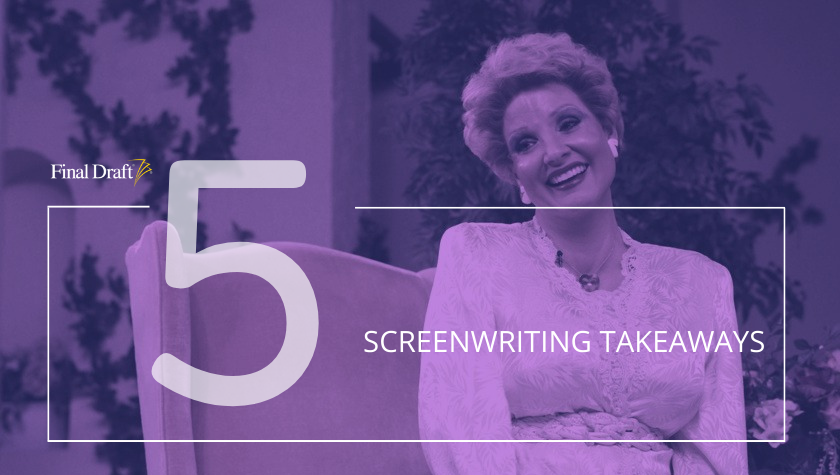Desire: The Driving Force of All Successful Screenplays
December 3, 2015
For my entire career as a screenwriting instructor, author and consultant, I have held a single guiding principle: the essential component of all successful movies is the hero’s pursuit of a compelling desire.
Desire: The Driving Force of All Successful Screenplays
- The desire must be visible.
- The desire must have a clearly implied endpoint.
- Your hero must desperately want the desire.
- Your hero must actively pursue the desire.
- It must be within your hero’s power to achieve her desire.
- Your hero must put everything on the line to achieve the desire.
- Your hero’s desire must be resolved at the climax of the film.
In this article I want to examine this principle more closely, and discuss the specific elements that define what I refer to in my lectures and my book Writing Screenplays That Sell as outer motivation.
Your primary goal as a screenwriter must be to elicit emotion in the reader and the audience. Whatever else you hope to achieve with your script -- money, fame, artistry, a celebration of humanity or an enlightened, empowered audience -- you will do so only when you keep the movie or TV audience emotionally involved with your story. And you will only be given the opportunity to reach an audience if the people in power are emotionally involved as they read your screenplay.
This necessary emotional involvement is realized only when the audience experiences the events of your story through your characters. Without giving your hero some compelling desire to pursue, your story will have no forward movement, your audience will have nothing to root for, and your reader will have no compelling reason to keep turning the pages of your script.
It is this necessary desire that defines your story concept. Ask someone what Independence Day is about, and they’ll probably say something like, “It’s about a group of people trying to stop an alien invasion.” Or read the loglines for movies and TV episodes in TV Guide. Almost all of them state or imply the primary desires the heroes will pursue.
Certain qualities distinguish an effective outer motivation and insure its potential for creating an emotional experience:
1) The desire must be visible.
I use the term OUTER MOTIVATION because it is outwardly apparent to the audience as they watch the action on the screen. Whether it’s stopping Mr. Smith and saving the world in The Matrix Revolutions, reuniting with his high school dream girl in There’s Something About Mary, or Finding Nemo in that film, the heroes of those films are doing things to achieve their desires, not simply revealing themselves through dialogue.
In other words, outer motivation does not involve the desire for invisible, inner qualities like success, love, belonging, greed, revenge or self-worth. Any one of these might provide a reason your hero is pursuing her visible goal, but it's not the goal itself.
In the movie In The Line of Fire, Frank Horrigan wants desperately to make up for a moment of cowardice and hesitation early in his career. But this need doesn’t give the story a plot, it only justifies the real outer motivation: to stop the assassin from killing the current president.
2) The desire must have a clearly implied endpoint.
Not only do we see the hero pursue the goal throughout the movie, we can easily envision what achieving the goal will look like. We know when we watch Con Air that we will ultimately see a showdown between the hero and the villain. We may not know all the details, or exactly where and how it will occur, but we know that the outcome will resolve the story.
When you write a screenplay, you are taking the reader on a journey. But this isn’t one of those trips where you jump in the car and say, “Let’s just go for a drive and see where we end up.” In a movie, you are subconsciously telling the audience, “I’m taking you to this specific destination. I won’t tell you all the roadblocks we’ll encounter, or all the sights you’ll see along the way, but I promise that when the movie is over, you’ll be here.”
Think of your movie as a race. Your hero is trying desperately to reach the finish line before some other character or force of nature can stop her. If you don’t tell audience where the finish line is, how will they know what to root for? How will they even know when the movie’s over? (Yes, I know the credits will come on, but how exciting is that?)
This is another way that outer motivation is distinguished from some inner desire for self-worth -- what I term INNER MOTIVATION. It’s fine if your hero wants acceptance, for example, but how will the audience know he’s achieved it unless you link that acceptance to some visible outer motivation we can anticipate? In Amadeus, a jealous Salieri wants to get revenge (invisible) on God for making Mozart a musical genius. This instills in him a visible desire to destroy Mozart. It is murdering Mozart that drives the story forward, gives it a clearly defined endpoint, and keeps the audience emotionally involved.
3) Your hero must desperately want the desire.
If your main character is only mildly interested in achieving his or her outer motivation, how can you expect the audience to care whether it is achieved or not? It’s your hero’s burning passion that will draw readers into your screenplay, and will make the outcome of vital importance to them as well.
4) Your hero must actively pursue the desire.
Your characters can’t simply sit around talking about how much they’d like to have money, success, or the love of a beautiful woman. They must take control of their lives and use every ounce of strength, courage and intelligence they have to rob the bank, stop the serial killer, or win the love of the prom queen.
Nor can your hero simply observe other characters pursue a goal, or allow others to pursue them without reacting. By definition, the hero is the character whose desire defines the plot of the movie.
Passive heroes destroy interest and emotion. How can we root for someone who takes no action? Your protagonist can be passive at the beginning of your script, but before too long, he has to declare, “I WANT THAT!” and go after his desire.
5) It must be within your hero’s power to achieve her desire.
You never want your hero to wait to be rescued, in any sense of the word. If she’s pursued by a killer, trapped in a mine shaft, or cornered by dinosaurs, she can’t wait helplessly for the Mounties to arrive.
This is why very few successful movies are about elections, beauty pageants, or the Pillsbury Bake-Off: The outcome of such situations is determined by voters or judges, not by the one pursuing the prize. (Yeah, yeah, I know, Miss Congeniality was about a beauty pageant. But what was her Outer Motivation? To stop the killer – not to be picked as the winner.)
The exception to this principle is the courtroom drama, where a judge or jury ultimately decides whether the hero wins or loses. But notice that in most successful legal dramas, such as A Few Good Men, Class Action, or Runaway Jury, the verdict is preceded by a scene where the hero confronts an antagonistic witness, reveals key evidence, or makes an impassioned plea that transforms the outcome into a foregone conclusion.
6) Your hero must put everything on the line to achieve the desire.
Again, the more passionate, determined and courageous your hero is in pursuit of his quest, the greater the audience’s own emotional involvement, and the greater their elation when he succeeds.
This principle is fairly evident in action movies and thrillers like Terminator 3, X Men 2, or Panic Room, where heroes put their lives on the line to save the world, stop the bad guys or escape from danger. But it’s also true in any successful love story or comedy. The Robin Williams character in The Birdcage risks embarrassment, humiliation, self-esteem, the loss of his lover and the loss of his own son’s love and happiness in his attempt to convince his future in-laws that he’s a straight man.
And in romantic comedies and love stories like Sleepless In Seattle, Good Will Hunting, and As Good As It Gets, the heroes must take the greatest emotional risk of all: exposing themselves to rejection, fear and pain as they let go of identities that have brought them a lifetime of protection. But they find the courage to put everything on the line as they pursue their love and their destiny.
7) Your hero’s desire must be resolved at the climax of the film.
You may add ambiguous elements to your story, and even leave your hero with an uncertain future. But you must resolve both the Outer and Inner Motivations by the end of the film. Your reader and audience have spent two hours rooting for your hero to achieve these compelling desires. You can’t now leave them hanging and expect your script to either advance your career or transform your audience.
Written by: Final Draft




